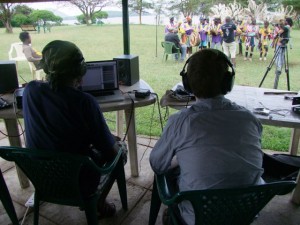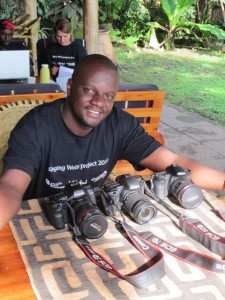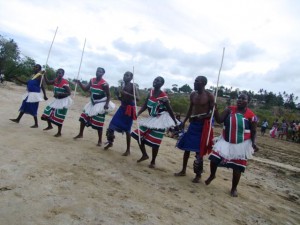Just as we are about to embark our fifth field recording visit, this time to northern Uganda, Andy reflects on a typical day in the field as part of the Singing Wells team. Andy’s notes are also published in our new book ‘Singing Wells – The Story So Far’, newly available in hardback. Click here for more details.
A typical field recording day
A Singing Wells day in the field usually starts with an early breakfast after which the team assembles at the vehicles with the mobile recording equipment. Typically the team is ten people – a mix of technicians from both Nairobi based Ketebul Music and London based Abubilla Music. We are invariably joined by a local ‘fixer’ who will take us to the village and introduce us to the music groups who are expecting us.
Once we arrive in our location, we liaise with the local musicians to find the best space to record. If possible we will record more than one of groups in each location, as it reduces the setup and breakdown time and maximizes the time for recording. We decide on two or three different ‘backdrops’ for the performances and park vehicles in the centre so that we can easily rotate the setup while leaving the back end of the audio equipment setup in place.
 We have two mobile recording units, each capable of recording from four microphones plus other sources at a high resolution to Apple MacBook Pro laptops. The benefit of the systems we have chosen is that they can run off the battery power of the laptops if we are in the situation where we do not have a generator (or there is a power cut mid-session which happened to us when we recorded to the Batwa at the Travellers Rest Hotel in Kisoro, Uganda!)
We have two mobile recording units, each capable of recording from four microphones plus other sources at a high resolution to Apple MacBook Pro laptops. The benefit of the systems we have chosen is that they can run off the battery power of the laptops if we are in the situation where we do not have a generator (or there is a power cut mid-session which happened to us when we recorded to the Batwa at the Travellers Rest Hotel in Kisoro, Uganda!)
We can also combine the two recording units into one to increase the number of inputs, while still working off battery power. The laptops use Avid ProTools recording software – an industry standard for recording and music production. The microphones we have chosen are industry standard models used in studios the world over but, most likely, not seen in the villages of East Africa.
The equipment has been carefully selected so it can easily fit into four rugged peli-cases which protect everything while in transit, whether it be on a plane from Nairobi or in the back of the van on a bumpy track to one of the remote villages we are heading for.
We are adding to our equipment lists all of the time as we refine our methods and learn new techniques and face new challenges. For our next field recording trip to northern Uganda (December 2012), this is the list of everything we will be taking with us:
- 2 Apple 17″ MacBook Pro

- 2 MOTU Traveler MK3 Audio Interface
- 4 Headphone amps
- 8 Sony MDR-V600 headphones
- 2 Shure mics & stands
- 2 Rode Lavalier omni-directional mics
- 2 Rode NTG-1 condenser Shotgun mics
- 1 Matched Pair of AKG C414 XL Microphones
- 1 Matched Pair of Rode NT5 Microphones2 Rode professional boom pole
- 1 K&M telescopic mic stand/boom
- 1 Canon EOS 7D
- 1 Canon EOS 60D
- 1 Canon EOS 5D
- 1 LED video camera lights
- 1 Flip HD video camera
- ThinkTank sun screens (for the laptops)
- Various Canon zoom and fixed lenses
Plus at least 9 Sandisk memory cards and 15 portable back-up drives and a lot of leads and cables!
Having settled on our first location the video engineers set up their shots while the audio engineers set up the recording rigs. The video engineers are working with Canon digital SLR cameras. One camera is used as a main locked-off shot of the whole scene while the two other cameras concentrate on close-ups of the performers. The idea behind the locked-off shot is that it will function as the simplest form of presentation of the material with audio sync.
Once the microphones are set up we ask the musicians to perform a few bars of their first track to check the microphone gains and record levels. The video team check their shots and talk about who will be covering which part of the footage.
 Then, once we are setup, we begin to record the performances. Takes are logged by the day, so the first take of the day becomes take number one. Note taking and logging is incredibly important as one recording trip can involved eight or more groups over a four-day period. Once we have finished recording the first group we assess whether we want to record any ‘Magic Moments’. These are where we film and record a musician performing solo on his or her instrument and are notable by the interesting nature of the instrument or the virtuosity of the performance.
Then, once we are setup, we begin to record the performances. Takes are logged by the day, so the first take of the day becomes take number one. Note taking and logging is incredibly important as one recording trip can involved eight or more groups over a four-day period. Once we have finished recording the first group we assess whether we want to record any ‘Magic Moments’. These are where we film and record a musician performing solo on his or her instrument and are notable by the interesting nature of the instrument or the virtuosity of the performance.
We then move to our second ‘set’ or angle on the site. Locations are chosen aesthetically, based on what is available. Other considerations include any useful shelter (it can rain suddenly and heavily) along with the direction of the sun and any sources of noise.
Once we have set up for the next group, we begin again by doing a sound check to set the mic gains and the record levels. We then name our audio files so that the take numbers continue from the last performance. We are careful that each take has its unique and concurrent take number on the off chance that audio files become separated from their record location. This way we can always work out exactly where each audio file has been recorded and when.
At the end of the day it is important to backup the files. Each night, back at our accommodation, we backup the audio and video data to multiple mobile hard disks so we can re-use the memory cards again the next day.
After a debrief on the day’s activities, we run through the times for breakfast and departure on the next day of recording. An early night usually follows.
